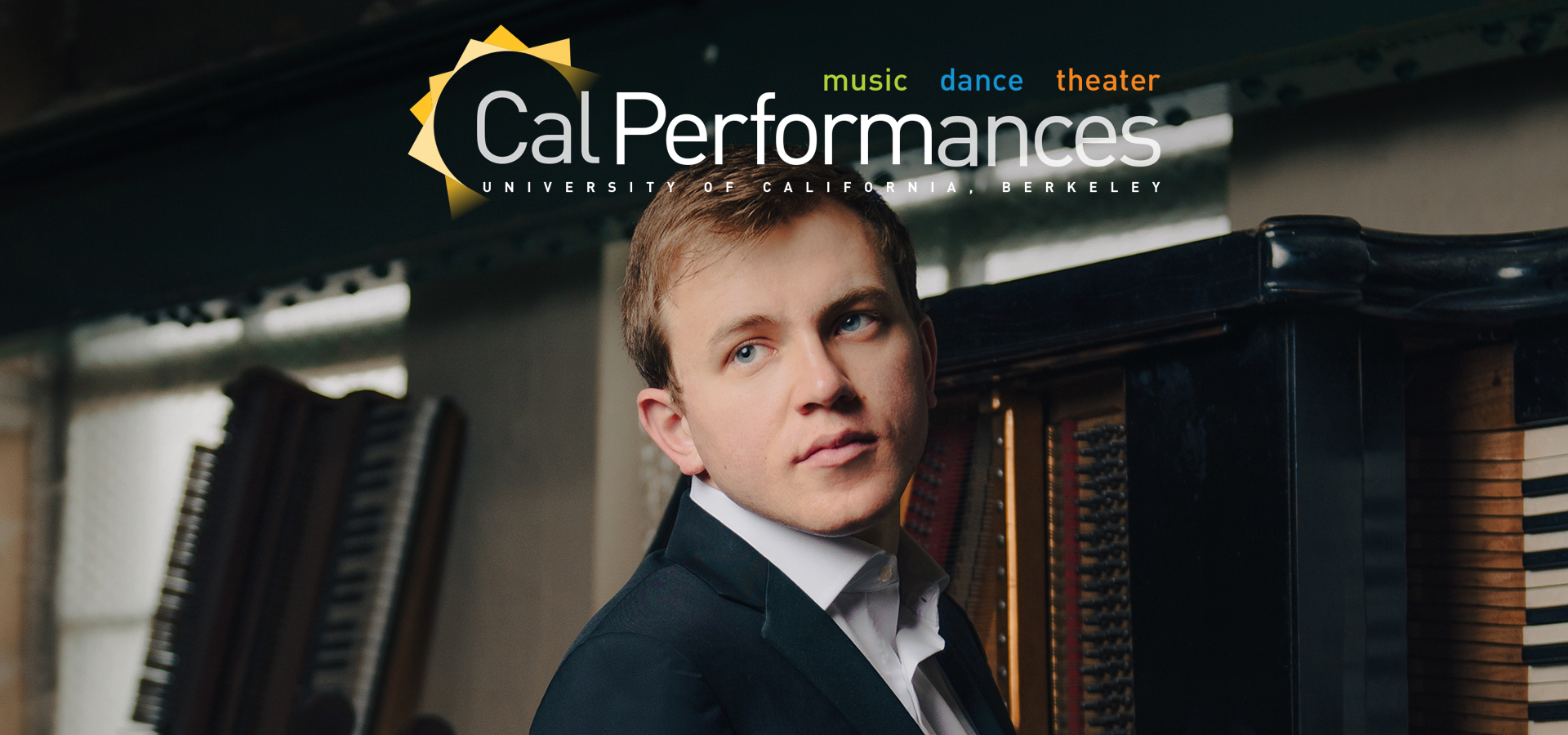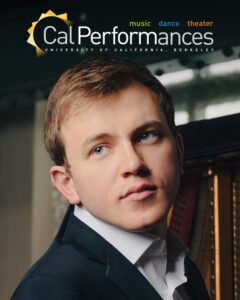Filippo Gorini, piano
Sunday, January 28, 2024, 3pm
Hertz Hall
Cal Performances is committed to fostering a welcoming, inclusive, and safe environment for all—one that honors our venues as places of respite, openness, and respect.
Please see the Community Agreements section on our Policies webpage for more information.
This program will be performed without intermission and last approximately one hour and 40 minutes.
From the Executive and Artistic Director

Happy New Year from Cal Performances! I’m so pleased to welcome you back to campus as we launch the second half of our extraordinary 2023–24 season. We begin this month with the return of two audience favorites—jazz diva Cécile McLorin Salvant and the ever-popular Les Ballets Trockadero de Monte Carlo—as well as the highly anticipated Berkeley debut of the brilliant young Italian pianist Filippo Gorini.
As we enter the busiest months on our calendar, we’ll continue a season distinguished by an array of carefully curated events designed to appeal to the eclectic interests and adventurous sensibilities of Bay Area audiences. In total, this year’s schedule features nearly 30 companies, ensembles, and solo artists new to our program, offering a wide range of opportunities to discover unfamiliar performers and artworks. There’s plenty to enjoy, including six world premieres, six Cal Performances co-commissions, nearly one dozen local and regional premieres, and the West Coast premieres of Taylor Mac & Matt Ray’s Bark of Millions (see page 6 for more details) and Nathalie Joachim’s Ki moun ou ye (Who are you?).
Cal Performances continues to invest in ongoing relationships with established and acclaimed artistic partners, with upcoming presentations including a landmark collaboration between Germany’s Pina Bausch Foundation, Senegal’s École des Sables, and the UK’s Sadler’s Wells theater in the first-ever Bay Area performances of Bausch’s pioneering The Rite of Spring (1975), as well as the renewal of a multi-season residency by The Joffrey Ballet, which this year will present its first full-length narrative ballet, Anna Karenina, at Zellerbach Hall. And I’m especially pleased that in March, the renowned pianist Mitsuko Uchida will join us as Artist in Residence for two special concerts as well as additional opportunities for the campus and wider Bay Area community to engage with her singular artistry.
An ongoing focus of the season is our multi-dimensional Illuminations programming, which once again connects the work of world-class artists to the intellectual life and scholarship at UC Berkeley via performances and public programs investigating a pressing theme—this season, “Individual & Community.” Concepts of “individual” and “community” have been at the forefront of public discourse in recent years, with new questions emerging as to how we can best nurture a sense of community and how the groups we associate with impact our own sense of self. Given our fast-evolving social landscape, how can we retain and celebrate the traits that make each of us unique, while still thriving in a world that demands cooperation and collaboration? With the performing arts serving as our guide and compass, our 2023–24 “Individual & Community” programming will explore the tensions that come into play when balancing the interests of the individual with those of the group.
Again, welcome to Cal Performances! We’re delighted to begin the new year together, celebrating the very best in live music, dance, and theater.
Jeremy Geffen
Executive and Artistic Director, Cal Performances
 Happy New Year from Cal Performances! I’m so pleased to welcome you back to campus as we launch the second half of our extraordinary 2023–24 season. We begin this month with the return of two audience favorites—jazz diva Cécile McLorin Salvant and the ever-popular Les Ballets Trockadero de Monte Carlo—as well as the highly anticipated Berkeley debut of the brilliant young Italian pianist Filippo Gorini.
Happy New Year from Cal Performances! I’m so pleased to welcome you back to campus as we launch the second half of our extraordinary 2023–24 season. We begin this month with the return of two audience favorites—jazz diva Cécile McLorin Salvant and the ever-popular Les Ballets Trockadero de Monte Carlo—as well as the highly anticipated Berkeley debut of the brilliant young Italian pianist Filippo Gorini.
As we enter the busiest months on our calendar, we’ll continue a season distinguished by an array of carefully curated events designed to appeal to the eclectic interests and adventurous sensibilities of Bay Area audiences. In total, this year’s schedule features nearly 30 companies, ensembles, and solo artists new to our program, offering a wide range of opportunities to discover unfamiliar performers and artworks. There’s plenty to enjoy, including six world premieres, six Cal Performances co-commissions, nearly one dozen local and regional premieres, and the West Coast premieres of Taylor Mac & Matt Ray’s Bark of Millions (see page 6 for more details) and Nathalie Joachim’s Ki moun ou ye (Who are you?).
Cal Performances continues to invest in ongoing relationships with established and acclaimed artistic partners, with upcoming presentations including a landmark collaboration between Germany’s Pina Bausch Foundation, Senegal’s École des Sables, and the UK’s Sadler’s Wells theater in the first-ever Bay Area performances of Bausch’s pioneering The Rite of Spring (1975), as well as the renewal of a multi-season residency by The Joffrey Ballet, which this year will present its first full-length narrative ballet, Anna Karenina, at Zellerbach Hall. And I’m especially pleased that in March, the renowned pianist Mitsuko Uchida will join us as Artist in Residence for two special concerts as well as additional opportunities for the campus and wider Bay Area community to engage with her singular artistry.
An ongoing focus of the season is our multi-dimensional Illuminations programming, which once again connects the work of world-class artists to the intellectual life and scholarship at UC Berkeley via performances and public programs investigating a pressing theme—this season, “Individual & Community.” Concepts of “individual” and “community” have been at the forefront of public discourse in recent years, with new questions emerging as to how we can best nurture a sense of community and how the groups we associate with impact our own sense of self. Given our fast-evolving social landscape, how can we retain and celebrate the traits that make each of us unique, while still thriving in a world that demands cooperation and collaboration? With the performing arts serving as our guide and compass, our 2023–24 “Individual & Community” programming will explore the tensions that come into play when balancing the interests of the individual with those of the group.
Again, welcome to Cal Performances! We’re delighted to begin the new year together, celebrating the very best in live music, dance, and theater.
Jeremy Geffen
Executive and Artistic Director, Cal Performances
A Note from the Artist
In February 2020, with newfound time and thirst for something profound, I conceived a plan for a unique exploration. My work on The Art of Fugue, Johann Sebastian Bach’s mystical, unfinished masterpiece, had begun in 2013, but it was only thanks to these long months of silence and the support of the Borletti–Buitoni Trust Award that I was able to study it with enough dedication to offer it to the public.
The triumphs of intellect and craft, the symbols and layers of meaning hidden within this work’s conception are one with the moving singing that really is its heart. The view that it should be seen solely as a theoretical marvel is misguided: as the counterpoints and canons evolve in formal complexity, so does their emotional tension, until the heartbreaking mystery of the unfinished Fuga XIV.
Nothing makes me as passionate as delving into a deep work of music, taking a long time to make sense of it, and then sharing what I have achieved with an audience. This is the heart of making music for me as a performer, and when I received the news of the Borletti–Buitoni Trust Award, I knew I could use their support to finally bring to the world a project on Bach’s The Art of Fugue, a work I deeply love and had already been slowly studying since 2013.
—Filippo Gorini
(excerpted from album liner notes)
About the Program
The Art of Fugue (Die Kunst der Fuge) was Johann Sebastian Bach’s last masterpiece; Bach biographer Karl Geiringer calls it “one of the truly great creations of the human mind.” With its 14 fugues (one of them incomplete) and four canons, it is both a textbook of the contrapuntal possibilities to be derived from one potent theme in D minor and a profound musical experience for both performers and listeners. Besides systematically presenting the various fugal techniques, its individual numbers carry us through worlds of distinctive, highly varied moods and colors.
Already within his lifetime, Bach was renowned as the master of contrapuntal music and specifically the fugue form. Cognoscenti including King Friedrich of Saxony clamored to hear him improvise fugues at the keyboard. The Art of Fugue—a title Bach probably didn’t give the work himself (he actually used the Latin term contrapunctus or counterpoint rather than fugue throughout)—was probably largely composed during the early 1740s. However, in the last years of his life, Bach returned to it frequently, revising it for publication and adding new fugues and canons to make it a comprehensive final statement. Despite the fact that he was losing his eyesight, he even launched a formidable final fugue, which would utilize an astounding four subject themes. His death from a stroke after an unsuccessful eye operation on July 28, 1750 left this fugue uncompleted.
His musician sons led by Carl Philipp Emanuel Bach undertook to get the manuscript into order and published it posthumously in May 1751. However, Bach’s death not only left the final quadruple fugue incomplete, but the exact order of the work’s individual components undetermined. Another question also remained unresolved: exactly what instrument or instruments did Bach intend this massive work for? Most scholars believe it was designed for Bach’s own instruments of harpsichord or organ, but it can be performed by small ensembles as well. String quartets have adopted the work most effectively, and this writer has even heard it played by a saxophone quartet. Bach himself was always very flexible about having his music played by whatever suitable forces were available.
The word “fugue” is derived from the Latin verbs “fugare” and “fugere,” meaning “to chase” or “to flee.” And that’s exactly what our ears hear in this form in which the various imitative entrances of the subject theme seem to race after each other. For The Art of Fugue, Bach created a fairly simple subject in D minor with a strong profile opening with a leap that makes it easily recognizable in all its appearances even if it is flipped upside down or “inverted.” Transitional episodes between the sections of imitative subject entrances give a sense of relaxation and contraction between the moments of maximum contrapuntal excitement.
The fugues follow a textbook-like progression of fugal techniques of increasing complexity. Bach created four “simple” fugues containing only one subject, three counter-fugues in which the subject is partnered with its inverted form, four fugues with multiple subjects (all derived from the core theme) used simultaneously, and two pairs of “mirror” fugues in which the second fugue is an exact reversal or mirror image of the first. Sometimes we also hear the fugue theme sped up (diminution) or slowed down (augmentation).
The four canons do not follow the fugue form, but instead are contrapuntal pieces for two or more voices chasing each other in imitation, using many of the same devices. Finally, there is the mighty torso of a fugue in three subjects, which Bach may have intended to be combined with the original theme to make a quadruple fugue before death stopped him.
John Stone tells us that many Baroque theorists—and perhaps Bach himself—saw the fugue as “an adequate human representation of the harmonia mundi (the ancient notion of musical spheres or a divine music created by the revolutions of the heavenly bodies.” Certainly, in its mathematical and expressive perfection, The Art of Fugue is music that seems to touch realms beyond human existence. Two members of the Emerson String Quartet, which has often performed this work, expressed their awe-struck reactions. Violinist Eugene Drucker: “The whole last fugue seems to be striving towards something ineffable, something beyond the reach of mortal man (even as immortal a mortal as Bach). There is a sense throughout this cycle of Bach summing up a life’s work, utilizing every ounce of technical mastery and stretching the boundaries of what the ear can perceive and the mind can grasp.” And says violist Lawrence Dutton: “It unlocks a yearning that all of us have, to be connected to something bigger, something spiritual. Bach was making music that would connect people to God.”
A Brief Guide to the Fugues and Canons
Contrapunctus I, II, III & IV: Bach begins with four “simple” fugues introducing the work’s subject, a strong, straightforward theme that leaps upward to establish the chord of D minor and then moves smoothly to present its scale. In the third and fourth fugues, the subject is inverted, or turned upside down, but is still easily recognizable by the now downward jump between the first two notes. The counterpoint also becomes more chromatic and rhythmically complex. The third fugue introduces a variant of the subject that will be used in later fugues.
Canon alla ottava: Gorini has chosen to insert the four canons after each section of fugues. First we hear the canon at the octave with the two voices separated by that interval. The subject is related to The Art of Fugue’s main subject and still in D minor. In the second half of this canon, this subject is inverted. The rhythm is a fast, bouncing compound meter.
Contrapunctus V, VI & VII: With these three fugues, known as counter-fugues, the contrapuntal games become more complex. A new variant on the inverted version of the original subject, first heard back in Contrapunctus III, now becomes the main subject and is paired with its own inversion. Also these fugues use the stretto technique, in which all the entrances come more quickly and thus overlap each other. Described by Bach as “in the French style,” Contrapunctus VI is an elegant fugue, in which we hear the ornamentation popular in French Baroque music combined with the prominent dotted rhythms of the French overture style. It also deploys another contrapuntal device: the subject being answered by itself in diminution (notes going twice as fast). No. VII ups the ante by presenting the subject first in diminution, next in the treble at normal speed, and last, thundering in the bass, in augmentation (twice as slow).
Canon per augmentationem in contrario motu: This is the longest and most remarkable of the canons for two voices. It opens with the subject in the treble, followed by the bass imitating it in augmentation and upside down. Halfway through, the two voices change places. This canon’s harmonic coloration is daring with its heavy use of chromaticism blurring the key of D minor. At the end, everything resolves serenely into a chaste D in octaves.
Contrapuntus VIII, IX, X & XI: These are a set of intricate triple- and double-subject fugues that are highlights of The Art of Fugue. The magnificent No. VIII is the seedbed of the other three and especially of No. XI. Written for three voices, it presents three subjects: 1.) a twisting version of the original subject that incorporates chromatic motion as a key element; 2.) a more chromatically twisted version with stabbing repeated notes; and 3.) a breaking up of the first subject into little three-note groups. All of these are marvelously combined into a stunning whole, dominated dramatically by those repeated notes. The subject of the double-fugue Contrapunctus IX stretches the opening fifth leap of the original subject by another octave and sets it on a furious race. Grounding it is the more sober second subject—which indeed is the original one heard in the opening fugues. No. X is another double fugue. Bach borrows the third subject from Fugue No. VIII—the one with the three-note groups—to launch the contrapuntal activity. High in its register, the treble voice soon presents a contrasting second subject. A triple fugue, Contrapunctus XI is perhaps the most stupendous contrapuntal display of the entire work. It borrows No. 8’s three subjects, but inverts them and places them in a different order. First we hear the three-note subject that ended No. 8 and opened No. 10. Next comes the wildly chromatic subject that opened No. 8. And last comes No. 8’s second subject with the hammering repeated-note motive, which lends great drama to the close of this fugue. All are eventually combined to create a dazzling spiral galaxy that finally drives D minor to D major.
Canon alla duodecima in contrapuncto alla quinta: Again a two-voice canon intervenes before we hear the final set of fugues. This is a whirlwind of a piece issuing from a six-note flourish that will add zest throughout. The imitation is at the twelfth—an octave plus a fifth.
Contrapunctus XII and XIII: These are two pairs of mirror fugues in which we hear first the piece in its rectus (original) position and then completely inverted in all parts. The result is that we get four fugues for the price of two. No. XII is solemn and relatively slow; No. XIII is lively and propelled by triplet figures and dotted rhythms.
Canon alla decima in contrapunto alla terza: The answering voice in this canon is set an octave and a third above the subject in the bass. With notes tied over the bar lines, Bach provides appealing rhythmic conflict between the two voices. Midway through, the subject moves up to the treble voice.
Contrapunctus XIV: This triple fugue with three subjects is Bach’s most ambitious effort, left unfinished by his death in 1750. Scholars believe he intended it to be a quadruple fugue with the original Art of Fugue theme returning as the fourth subject and combined with the others. This idea is reinforced by the fact that the three subjects we have are all compatible with that original theme. The fugue opens with a majestic slow theme in the bass. This is thoroughly explored before the second subject in flowing eighth notes appears in the alto voice. Then for his third subject, Bach dramatically set out the four letters of his name as they appear in German notation—B (for B-flat), A, C, and H (B natural)—in the tenor voice. After this is fully presented, Bach began combining all three subjects, but just seconds later, the fugue stunningly breaks off.
—Janet E. Bedell © 2024
Janet E. Bedell is a program annotator and feature writer who writes for Carnegie Hall, the Metropolitan Opera, Los Angeles Opera, Caramoor Festival of the Arts, and other musical organizations.




